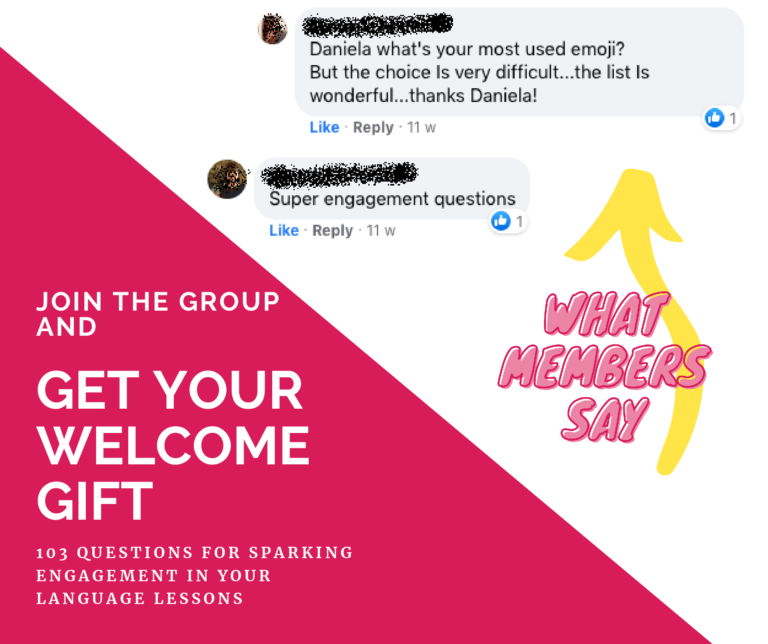
Students’ feedback matter. As a language teacher, you know this is important. If you are an independent language teacher, this is vital. Collecting your students’ opinion on the language classes you deliver is essential for laser spotting strengths and improvement areas of all aspects of your training. That is the reason why deciding on what questions for training feedback to include in your survey is so relevant for your success as a teacher and language business owner. In this article you are going to learn about the golden guidelines for creating the perfect after-training feedback questionnaire. Also, I prepared a free template you can use right away in your next courses.
Let’s say you have just delivered a language course and your students said they are happy with it. Alright, you are happy they are happy, right? But, is that enough? The simple comment “Oh, I loved your classes!” may fill your heart with joy, but it doesn’t help you to improve the quality of your training.
Also, you may know that even happy students don’t tell you the 100% of what they think about your training. Instead, they usually allow you to see the pick of the iceberg (a very quick comment dropped while they are stepping out of the classroom, usually). That is what people do: students, customers, anyone who tried some kind of service. In your case, it is a “training service”.
As language teachers, we always look to growing and doing things better. What can we do, then? How can we make sure we don’t miss out of a thing when it comes to learning about our students’ perspective on our own work?
Method and questions for training feedback
Here is the solution: creating a very simple framework for collecting students’ feedback in a structured, efficient, yet time-saving way. It is easier than you think, although there is a bunch of guidelines you shall stick to. The good news is that once you have created a good feedback questionnaire, you will be using it for all your courses!
One more good news is: I have created a free feedback form for you to download! So, if you don’t feel like writing a form from scratch, I’ve got you covered: you can use mine! That is exactly the form I use in all my courses (intensive courses, workshops, in-person seminars, etc.).
What type of questions for training feedback should you pick?
Good feedback forms collect information about every aspect of the training experience. There are 6 main categories to cover in a feedback questionnaire:
- Learning experience and achievements: this is about the students’ perception on their own progress compared to the training goals
- Method: this is about exercises, activities, methodologies the students have been involved in
- Teacher (communication, delivery): this is about the teacher’s communication skills
- Course materials: this is about the materials you provide the students with and that are supposed to support their learning
- Classroom, facilities: this is about the training room and the facilities – if a room is too dark, that could negatively affect the students’ perception on the training! Also, you want to put into this category every other “learning environment” (both off-line and online) where students took their classes or did other activities: e-learning platforms, websites and blogs, software for online teaching, etc.
- Organisational aspects: this is about how the organisational team did and if the people in charge of the logistic and organisational aspects have been able to give their practical support at all time during the training. Failing in sending out an email communicating the training schedule, for instance, may create the chaos!
Now, what a good set of questions for training feedback does is to help the students to evaluate each one of those aspect focussing on one score at a time. The whole point is to avoid an overall evaluation that would put together all those aspects because that would be too generic for us.
For example, many years ago a student in a course of mine said he had an overall bad experience, which surprised me because I could see he actually enjoyed the classes, he achieved the expected results and got on well with me. Nevertheless his experience was badly affected by the poor quality of the classroom and the facilities provided by company for which I delivered the course. If I hadn’t collected his detailed feedback through a proper, structured survey, I would have just thought I failed him. Instead, I discussed that piece of feedback with the company and they agreed to move the training course to another training room.
Should you avoid general questions for training feedback?
Absolutely not. On the contrary, you shall include general questions for training feedback in your surveys. The thing to avoid is to choose only general questions! By general questions I mean, for instance: how did you like the course? How would you rate the classes?
I recommend to pick general questions if you want ask your students for quick feedback after every single class. In that case, you can’t really ask them to fill in a 10-question feedback questionnaire every single time! What you can do, though, is to ask them to quickly and intuitively rate the class they have just taken.
When should your students answer the questions for training feedback?
The timing is really important. This is something so many teachers, schools and companies don’t take care of, unfortunately! The only reliable collected data come from surveys submitted right at the end of the training, when students are still in the classroom and the teacher is tidying up the training room, waiting for everybody to finish filling in their feedback form. Why is that?
Students express the most reliable opinion when the training has just finished and they still have a fresh memory of the training experience they had. Research says by the moment people leave the training room they change their mind because they begin to forget about many things about their training experience. On the other hand, if they fill in the form right after the training is over, they will be expressing a more sincere, not-filtered opinion.
That’s why you should always dedicate the very last 10 minutes of your course to giving out and asking to fill in the feedback forms.
What questions for training feedback you shouldn’t never forget about?
Don’t forget to ask very simple, open-ended questions such as: what did you like most? what did you like least?
Furthermore, remember to include a NPS (net promoter score) question, which is basically the questions asking how much they would recommend the course with you to their friends. The NPS is the only category rated on a scale from 1 to 10.
Finally, remember to leave some blank space as the bottom of the form for any comments. Give your students the chance to say what they couldn’t express in numbers or emoticons earlier!
Haven’t got time? Use mine! Here is the actual feedback form questionnaire I use in all my courses. Use it as it is or make adaptations… it’s my cheat-sheet for you!
What is the best rating scale for questions for training feedback?
Again, the research in people’s perception recommends to allow the students to rate each category (question) by using a 1 to 5 rating scale.
There is a debate going on regarding the use of emoticons (😃 🙂 🙁 ), rather than numbers (1, 2, 3, etc.) or adjectives (good, excellent, bad, etc.). In my experience, numbers help in aggregating data, whilst emoticons and adjectives help the students to fill in the form in an intuitive way. In my questionnaires I use both options.
Should feedback questionnaires be anonymous or not?
Totally anonymous. Why? Because you want your students to feel free to express their opinion. They will just feel like they can be authentic and spontaneous in putting down their thoughts on that form. And authenticity is exactly what you need!
Wrapping up
Briefly, to create your own end-of-training feedback questionnaire, write one question for each category (see above), choose a type of rating scale, make sure you include the better-not-to-forget questions I mentioned above as well as some space for free comments.
Thanks to feedback forms I have always been able to laser spot what in my students’ eyes I did well and what I needed to improve. And you know what? It is helpful both for when I am the teacher and for when I delegate the delivery to some other teacher from my teaching team.
Happy surveys!
Want more support?
Join the Facebook group Independent Language Teachers Collective to get daily advice, tons of free training and to branch out with other independent language teachers like you!
ALSO…
Available only for the Collective members: free list 103 question for sparking engagement in your language lessons.
This is what members say about the freebie:

Join in the Collective and grab your welcome gift:


